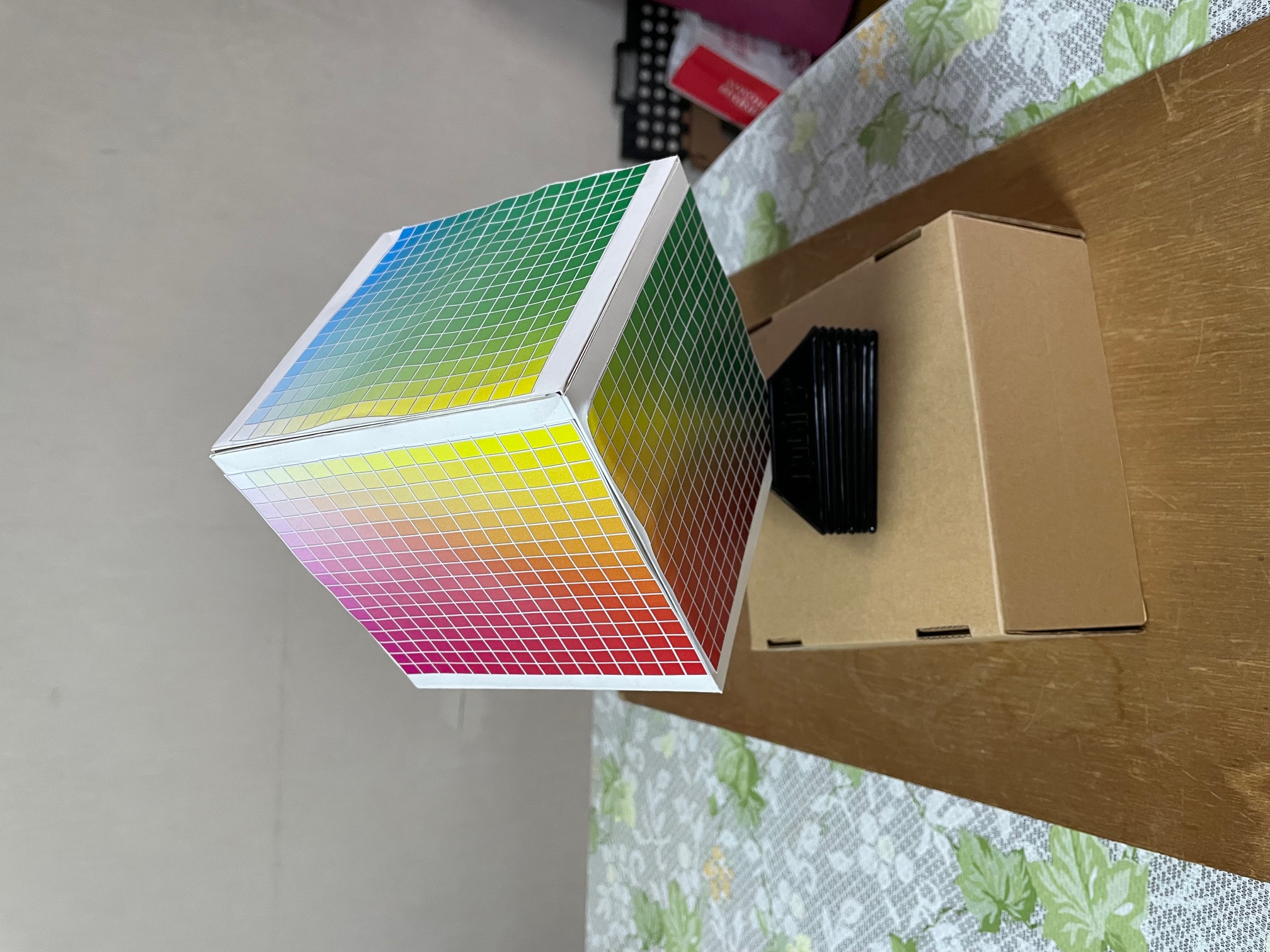
|
| Color Cube |
| Where is Blue?
http:// www.agu.ac.jp / ~vicks62 / jeffreyb / blue3. html |
|---|

|
| Color Cube |
| Reoriented White (top) |

|
| Black (bottom) |
Inside the Cyan Triangle, moving horizontally (perpendicular to the cyan-white line) flips cyan to white if you go right, and white to cyan if you go left. Moving vertically flips cyan to blue (down) OR blue to cyan (up). Inside the Magenta Triangle on the other hand, moving vertically flips white and magenta, while moving horizontally flips blue and magenta. What do you suppose happens when you move diagonally from the cyan corner to the magenta one? As you move through the Cyan Triangle, you flip two units of cyan to one blue unit and one white. After you cross into the Magenta Triangle, you flip one blue unit and one white unit into two magenta ones.
|
color systems |
pigment | Crayola | Munsell | Natural CS | Pantone |
| r-g-b | 3333-99 | 1f-75-fe | 00-93-af | 00-87-bd | 00-18-a8 |
| blue | |||||
| rr-gg-bb | 3333-99 | 22-77-ff | 00-99-aa | 00-88-bb | 00-11-aa |
| 15 interval analysis |
c[ 0] [ 3]w b[ 6] [ _]m |
c[ 5] [ 2]w b[ 8] [ _]m |
c[ 9] [ 0]w b[ 1] [ _]m |
c[ 8] [ 0]w b[ 3] [ _]m |
c[ 1] [ 0]w b[ 9] [ _]m |
Above are some other versions of "blue". Let's mark them (or their upper projection) with an "x" on the top layer of the Color Cube (below).
| 000 black | 00f blue |
f0f magenta | 0ff cyan |
fff white |
This is the blue "pallette". You can use
magenta OR cyan, but NOT together.
What about some other shades of blue? Where are they? What are their proportions?
| (op) opal = abb | c[ 1] [10]w b[ 0] [ _]m |
|
| (cd) cadet blue = aab | c[ 0] [10]w b[ 1] [ _]m |
|
| (st) steel blue = 48b | c[ 4] [ 4]w b[ 3] [ _]m |
|
| (sf) sapphire = 15b | c[ 4] [ 1]w b[ 6] [ _]m |
[blue]
[red]
[green]
[0]
[1]
[2]
[3]
Black = 4
[5]
[6]
[7]
| c [11] 00-bbbb |
P4 | op | b | w [11] bbbbbb |
|||||||||||||
| 00-aa-bb |
cd | bb-aa-bb |
|||||||||||||||
| 00-99-bb |
9 | bb-99-bb |
|||||||||||||||
| 00-88-bb |
st | M5 | 8 | bb-88-bb |
|||||||||||||
| 00-77-bb |
7 | bb-77-bb |
|||||||||||||||
| 00-66-bb |
6 | bb-66-bb |
|||||||||||||||
| 00-55-bb |
sf | 5 | bb-55-bb |
||||||||||||||
| 00-44-bb |
4 | bb-44-bb |
|||||||||||||||
| 00-33-bb |
3 | I3 | bb-33-bb |
||||||||||||||
| 00-22-bb |
2 | bb-22-bb |
|||||||||||||||
| 00-11-bb |
1 | bb-11-bb |
|||||||||||||||
| b [11] 0000-bb |
0 | m [11] bb-00-bb |
| red [0] | 0 | 1 | 2 | 3 | 4 | 5 | 6 | 7 | 8 | 9 | a | b | red [11] |
| (cd) cadet blue = aab | c[ 0] [10]w b[ 1] [ _]m |
|
| (C1-7) Indigo = 408 | c[ _] [ 0]w b[ 4] [ 4]m |
|
| (77-7) navy blue = 008 | c[ _] [ 0]w b[ 8] [ 0]m |
Upper projections (on the right) of darker colors (less than 12 units of light) in the Blue Zone:
| pine green = 077 | +444=4bb | P4 | |
| midnight blue = 036 | +555=58b | M5 | |
| navy blue = 008 | +333=33b | 3 | |
| midnight blue = 227 | +444=66b | 6 | |
| indigo = 408 | +333=73b | I3 | |